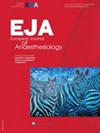雷马唑仑对术中低血压的影响:随机对照试验的系统回顾和荟萃分析。
IF 4.2
2区 医学
Q1 ANESTHESIOLOGY
引用次数: 0
摘要
背景麻醉期间低血压很常见。越来越多的研究报告称,与其他麻醉药相比,雷马唑仑可能会降低术中低血压的发生率。本研究旨在评估雷马唑仑对术中低血压及其相关结果(低氧血症、心动过缓和清醒时间)的影响。数据来源检索了PubMed、Cocharane和Embase数据库,以确定截至2024年6月发表的符合条件的RCT。研究对象为18岁或以上的患者,他们在术前或术中均接受了雷马唑仑和其他阳性对照药的治疗。结果本研究评估了 34 项试验,包括 4847 人。根据中度确定性证据,我们发现服用雷马唑仑可降低术中低血压[风险比(RR)= 0.48,95% 置信区间(95% CI):0.41 至 0.57]和心动过缓(16 项研究,n = 2869,RR = 0.40,95% CI:0.29 至 0.54)的发生率。在低氧血症发生率(RR = 0.70,95% CI:0.48 至 1.01)和清醒时间(MD = -0.91,95% CI:-2.42 至 0.60)方面未观察到差异。不管是全身麻醉还是手术镇静,雷马唑仑与低血压之间的明显关联性仍然稳固且显著(P < 0.01,I2 = 82%)。结论中等质量的证据表明,对接受全身麻醉或手术镇静的患者使用雷马唑仑可降低术中低血压和心动过缓的发生率。本文章由计算机程序翻译,如有差异,请以英文原文为准。
Effect of remimazolam on intra-operative hypotension: Systematic review and meta-analysis of randomised controlled trials.
BACKGROUND
Hypotension is common during anaesthesia. Increasing number of studies have reported that remimazolam may be associated with lower incidence of intra-operative hypotension compared with other anaesthetics. However, the results remain controversial.
OBJECTIVE
This study aimed to evaluate the influence of remimazolam on intra-operative hypotension and its related outcomes (hypoxaemia, bradycardia and time to awake).
DESIGN
A systematic review of randomised controlled trials (RCTs) with meta-analyses.
DATA SOURCES
PubMed, Cocharane and Embase databases were searched to identify eligible RCTs published up to June 2024.
ELIGIBILITY CRITERIA
RCTs published in English were eligible for inclusion. The study patients were 18 years or older who were administered with remimazolam and other positive control agents in either the pre-operative or intra-operative period. The incidence of intra-operative hypotension was identified in these studies.
RESULTS
This study evaluated 34 trials including 4847 individuals. Basing on moderate-certainty evidence, we found that remimazolam administration reduced the incidence of intra-operative hypotension [risk ratio (RR) = 0.48, 95% confidence interval (95% CI): 0.41 to 0.57] and bradycardia (16 studies, n = 2869, RR = 0.40, 95% CI: 0.29 to 0.54). No difference was observed in the incidence of hypoxaemia (RR = 0.70, 95% CI: 0.48 to 1.01) and time to awake (MD = -0.91, 95% CI: -2.42 to 0.60). The remarkable association between remimazolam and hypotension remained robust and significant, regardless of general anaesthesia or procedural sedation (P < 0.01, I2 = 82%). No significant difference was found between different control drugs (P = 0.97, I2 = 82%).
CONCLUSION
Moderate-quality evidence shows that remimazolam administration to patients undergoing general anaesthesia or procedural sedation decreases the incidence of intra-operative hypotension and bradycardia.
求助全文
通过发布文献求助,成功后即可免费获取论文全文。
去求助
来源期刊
CiteScore
6.90
自引率
11.10%
发文量
351
审稿时长
6-12 weeks
期刊介绍:
The European Journal of Anaesthesiology (EJA) publishes original work of high scientific quality in the field of anaesthesiology, pain, emergency medicine and intensive care. Preference is given to experimental work or clinical observation in man, and to laboratory work of clinical relevance. The journal also publishes commissioned reviews by an authority, editorials, invited commentaries, special articles, pro and con debates, and short reports (correspondences, case reports, short reports of clinical studies).

 求助内容:
求助内容: 应助结果提醒方式:
应助结果提醒方式:


